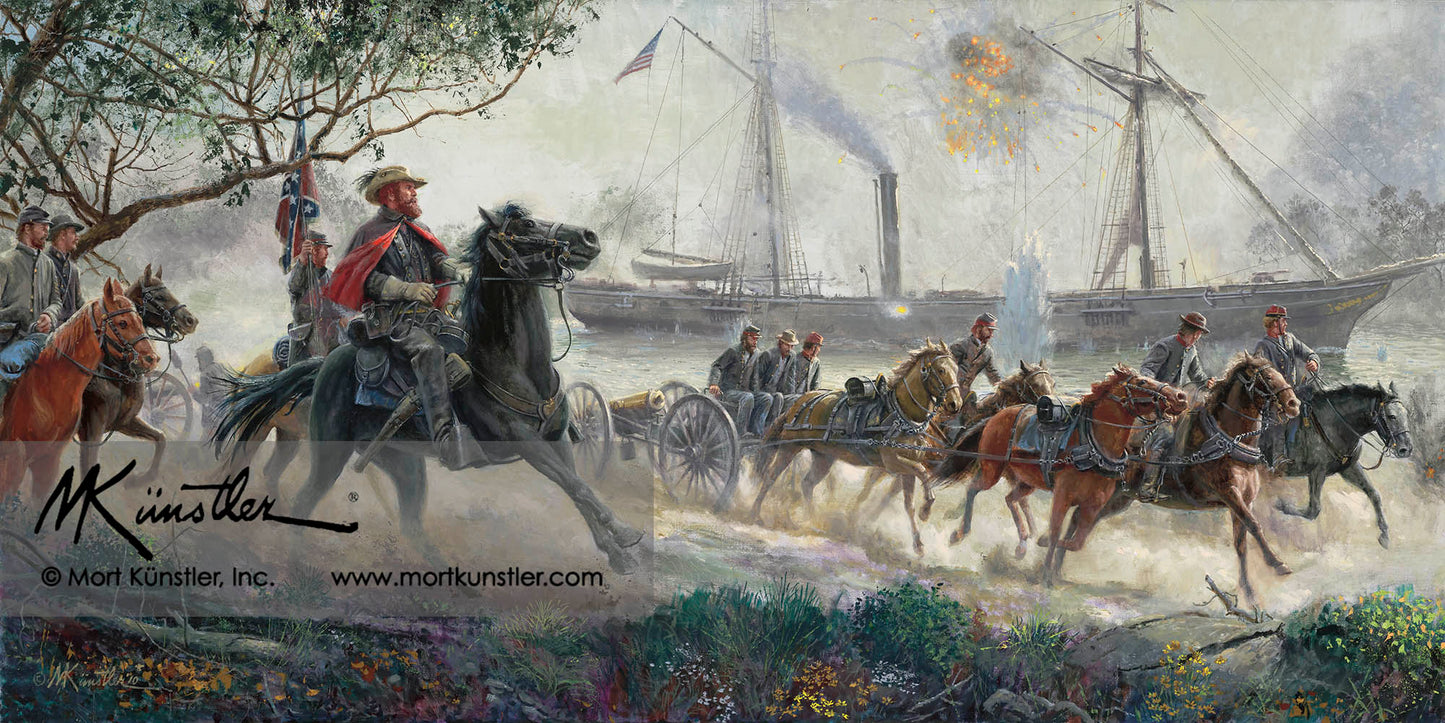The Official Mort Künstler Website
Strangest Race, The - limited edition print
Strangest Race, The - limited edition print
J.E.B. Stuart, White House, VA, June 29, 1862
Couldn't load pickup availability
* Free shipping within the Continental United States.
Custom framing is available for this print. Please call 800-850-1776 or email info@mortkunstler.com for more information.
LIMITED EDITION PRINTS
Paper Prints
Reproduction technique: Fine offset lithography on neutral pH archival quality paper using the finest fade-resistant inks.
Each print is numbered and signed by the artist and accompanied by a Certificate of Authenticity.
Image Size: 15” x 30” • Overall Size: 20” x 34”
Signed & Numbered • Edition Size: 350
Signed Artist’s Proof • Edition Size: 50
Giclée Canvas Prints
Reproduction technique: Giclées are printed with the finest archival pigmented inks on canvas.
Each print is numbered and signed by the artist and accompanied by a Certificate of Authenticity.
Signature Edition 14” x 28”
Signed & Numbered • Edition Size: 50
Signed Artist’s Proof • Edition Size: 10
Classic Edition 17” x 34”
Signed & Numbered • Edition Size: 50
Signed Artist’s Proof • Edition Size: 10
Premier Edition 22” x 44”
Signed & Numbered • Edition Size: 15
Signed Artist’s Proof • Edition Size: 5
Historical Information
The summer of 1862 witnessed one of the most unusual skirmishes of the entire American Civil War. Confederate cavalry commander Jeb Stuart received information that there were 5,000 Union soldiers guarding a nearby depot and decided to attack. As the sun rose the following day, Stuart’s troopers arrived at the location, only to find that the enemy had already departed.
Less than a mile away, the rebel cavalry discovered the Union gunship U.S.S. Marblehead, anchored on the nearby Pamunkey River, close to the shoreline. Stuart immediately ordered a detachment of his men to attack the ship and prevent its escape. As they neared, Federal troops disembarked and began firing on the horsemen.
Major John Pelham, a gifted Confederate officer, positioned his horse-drawn artillery along the shoreline and was able to fire several shots that exploded above the Union ship. What followed was a highly unique melée in which cavalry, naval and artillery units engaged one another.
As the gunboat gathered steam, its defenders were called back on board and the ship quickly withdrew downstream. Pelham’s men continued to follow it along the water’s edge, firing at the retreating vessel for as long as their horses could keep pace with it.
The Marblehead finally managed to escape from its pursuers. Later, it was reassigned to the South Atlantic Blockading Squadron. There, the ship commenced to patrol the southeastern coast in search of Confederate vessels. After several reassignments, she was finally decommissioned in September of 1868.
Mort Künstler’s Comments
I constantly read Civil War books, searching for incidents that will make interesting paintings. While reading JEB Stuart, The Last Cavalier by Burke Davis, I discovered an account of a unique engagement that took place along the Richmond-York Railroad on June 29, 1862. In this fight, Major John Pelham, a renowned Confederate artillery officer, revolutionized the usage of light artillery as a mobile arm of Stuart’s cavalry. According to Davis:Jeb sent 75 men to duel with the vessel, the U.S.S. Marblehead. Stuart’s troopers went over an open meadow about forty paces apart, ready with rifles. Whistling shells from the gunboat flew overhead. Bluecoat skirmishers came ashore and from the riverbank blazed away at the Confederates until one of Pelham’s howitzers fired, exploding a shell just over the Marblehead. The boat began to gather steam, called in her skirmishers and fell downstream under Pelham’s fire. There was a strange race between the gunboat and Pelham’s piece, which rumbled along the bank as far as the horses would go. Stuart and his staff trotted to the White House.
Although it was not a major skirmish, I envisioned this short narrative as the perfect element in the development of a totally unusual painting that had never been done before. Aside from giving me an opportunity t opaint horse-drawn artillery in full action, it gave me the chance to portray the "Gallant Pelham" for the first time. I hope the viewer enjoys this painting, the first in a series of strange events of the Civil War.
Historical copy written by Michael Aubrecht, author and historian





